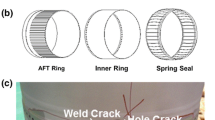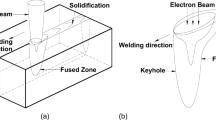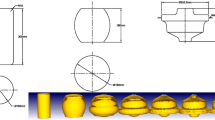Abstract
Most thin-walled parts of aero-engines with intricate surfaces, such as lobe mixer, are welded using tungsten inert gas (TIG), which will certainly induce stress and distortion, causing a serious influence on assembly accuracy. The objective of this study was to establish a finite element model to optimize TIG wire filler welding sequence for an aero-engine lobe mixer composed of GH3044 nickel–based superalloy at the thickness of 2 mm. A new method for optimizing residual stress and distortion in the welding of large-size components was proposed. We carried out a 2-mm-thickness plate TIG wire filler welding experiment to obtain the ideal process parameters and validate the heat source model and thermal boundary condition, and also designed a set of frock clamp. The stress and distortion of the lobed mixer were analyzed under various welding sequences based on the established finite element model. The results showed that the peak residual stress difference of the lobe mixer is smaller using such a fixture. But different welding sequences affected the stress uniformity throughout the structural member. Only the symmetrical welding of single weld was a better process, with a peak distortion of 0.54 mm and more uniform stress distribution.




















Similar content being viewed by others
References
Soares C (2008) Gas turbine configurations and heat cycles, Gas Turbines. 67–118
Sivaprasad K, Raman SGS (2007) Influence of magnetic arc oscillation and current pulsing on fatigue behavior of alloy 718 TIG weldments. Mater Sci Eng A 448:120–127
Hong JK, Park JH, Park NK, Eom IS, Kim MB, Kang CY (2008) Microstructures and mechanical properties of Inconel 718 welds by CO2 laser welding. J Mater Process Technol 201:515–520
Tucker JD, Nolan TK, Martin AJ, Young GA (2012) Effect of travel speed and beam focus on porosity in alloy 690 laser welds. JOM 64:1409–1417
Ola OT, Ojo OA, Chaturvedi MC (2013) Laser arc hybrid weld microstructure in nickel based IN738 superalloy. Mater Sci Technol 29:426–438
Du W, Bai Y-L, Wang J, Wang al - Y, Du L, Liu D, Subramanian R, Natarajan B, Kaliyaperumal B, Wang J, Xu D (2018) Microstructure and properties of nickel - based superalloy C-276 pulse laser weld joints based on 0.381mm thickness. IOP Conf Ser Mater Sci Eng 439:022020
Khakzadshahandashti A, Rahimipour MR, Shirvani K, Razavi M (2019) Weldability and liquation cracking behavior of ZhS6U superalloy during electron-beam welding. Int J Miner Metall Mater 262(26):251–259
Chen J, Salvati E, Uzun F, Papadaki C, Wang Z, Everaerts J, Korsunsky AM (2020) An experimental and numerical analysis of residual stresses in a TIG weldment of a single crystal nickel-base superalloy. J Manuf Process 53:190–200
Vishvesha A, Pandey C, Mahapatra MM, Mulik RS (2017) On the estimation and control of welding distortion of guide blade carrier for a 660 MW turbine by using inherent strain method. Int J Steel Struct 17:53–63
Arbo SM, Tomovic-Petrovic S, Aunemo J, Dahle N, Jensrud O (2022) On weldability of aerospace grade Al-Cu-Li alloy AA2065 by wire-feed laser metal deposition. J Adv Join Process 5:100096
Jothi S, Sebald T, Davies HM, Reese ED, Brown SGR (2016) Localized microstructural characterization of a dissimilar metal electron beam weld joint from an aerospace component. Mater Des 90:101–114
Abioye TE, Zuhailawati H, Aizad S, Anasyida AS (2019) Geometrical, microstructural and mechanical characterization of pulse laser welded thin sheet 5052–H32 aluminium alloy for aerospace applications. Trans Nonferrous Met Soc China 29:667–679
Blackburn J (2012) Laser welding of metals for aerospace and other applications. Weld Join Aerosp Mater 75–108
Subramaniyan MK, Veeman D, Nallathambhi SS, Thanigainathan S (2022) Gas Tungsten arc welding of Ti-6Al-4V sheet for pressure vessels used in aerospace application: a detailed characterization of weldment. Int J Press Vessel Pip 200
Vahdatkhah P, Tabatabaee Kopaee SR, Vahdat khah H (2022) Weld repair of gas turbine disc: optimization of pulsed TIG welding process parameters and microstructural analysis of Cr–Mo-V Steel. Int J Adv Manuf Technol
Taraphdar PK, Kumar R, Pandey C, Mahapatra MM (2021) Significance of finite element models and solid-state phase transformation on the evaluation of weld induced residual stresses. Met Mater Int 27:3478–3492
Pandey C, Mahapatra MM, Kumar P, Saini N (2018) Effect of weld consumable conditioning on the diffusible hydrogen and subsequent residual stress and flexural strength of multipass welded P91 steels. Metall Mater Trans B Process Metall Mater Process Sci 49:2881–2895
Ueda Y, Murakawa H, Ma N (2012) Introduction to welding mechanics. Weld Deform Residual Stress Prev :1–34
Song X, Kyriakoglou I, Korsunsky AM (2009) Analysis of residual stresses around welds in a combustion casing. Procedia Eng 1:189–192
Guo Z, Ou X, Shuai G, Chen Y (2012) Numerical simulation of temperature field for TIG welding of aluminum alloy sheet based on the SYSWELD. Adv Mater Res 472–475:1945–1949
Zhao W, Li S, Ding J, Wei Y, Liu X, Song S (2019) Building framework for selecting finite element models of complex large welded structure of railway vehicles. Simul Model Pract Theory 97:101950
Liu X, Wei Y, Wu H, Zhang T, Liu S (2019) Effect of stamping dimensional deviations on residual stresses and deformation of resistance spot welded steel sheets. J Mater Process Technol 272:149–162
Liu X, Wei Y, Wu H, Zhang T (2020) Factor analysis of deformation in resistance spot welding of complex steel sheets based on reverse engineering technology and direct finite element analysis. J Manuf Process 57:72–90
Ma TJ, Tang LF, Li WY, Zhang Y, Xiao Y, Vairis A (2018) Linear friction welding of a solid-solution strengthened Ni-based superalloy: Microstructure evolution and mechanical properties studies. J Manuf Process 34:442–450
Shi X, Jin X, Lin H, Jing J, Li L, Wang C (2017) Joining of SiC nanowires-toughened SiC coated C/C composites and nickel based superalloy (GH3044) using Ni71CrSi interlayer. J Alloys Compd 693:837–842
Phillips AL, Phillips LG (1970) Welding Handbook
Handbook (2012) Academic Committee of the Superalloys, China superalloys handbook-Vol.1, China Quality Inspection Press and Standards Press of China.Volume-1 p-119
Qiang Sheng Z, Yuan Liu J, Yao Y, Hua Xu Y (2020) Mechanisms of lobed jet mixing: about circularly alternating-lobe mixers. Aerosp Sci Technol 98:105660
Qiang Sheng Z, Wu Z, Zu Ji J, Lin Huang P (2016) Chevron spoiler to improve the performance of lobed ejector/mixer. Int Commun Heat Mass Transf 77:174–182.
Akbari D, Sattari-Far I (2009) Effect of the welding heat input on residual stresses in butt-welds of dissimilar pipe joints. Int J Press Vessel Pip 86:769–776
Goldak J, Chakravarti A, Bibby M (1984) A new finite element model for welding heat sources. Metall Trans B 152(15):299–305
Acknowledgements
The authors gratefully acknowledged projects funded by the China Postdoctoral Science Foundation (No. 2020M671479) and Priority Academic Program Development of Jiangsu Higher Education Institutions (PAPD).
Funding
This work was supported by the China Postdoctoral Science Foundation (No. 2020M671479) and Priority Academic Program Development of Jiangsu Higher Education Institutions (PAPD).
Author information
Authors and Affiliations
Corresponding author
Ethics declarations
Ethical approval
Not applicable.
Consent to participate
The authors declare their consent to participate.
Consent for publication
The authors declare their consent for publication.
Conflict of interest
The authors declare no competing interest.
Additional information
Publisher's note
Springer Nature remains neutral with regard to jurisdictional claims in published maps and institutional affiliations.
Rights and permissions
Springer Nature or its licensor (e.g. a society or other partner) holds exclusive rights to this article under a publishing agreement with the author(s) or other rightsholder(s); author self-archiving of the accepted manuscript version of this article is solely governed by the terms of such publishing agreement and applicable law.
About this article
Cite this article
Jin, H., Chen, Z., Liu, X. et al. Numerical simulation research on welded residual stress and distortion of aero-engine afterburner lobe mixer with different welding sequences. Int J Adv Manuf Technol 126, 1329–1346 (2023). https://doi.org/10.1007/s00170-023-11210-w
Received:
Accepted:
Published:
Issue Date:
DOI: https://doi.org/10.1007/s00170-023-11210-w




